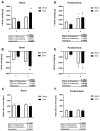Intense Caloric Restriction from Birth Protects the Heart Against Ischemia/Reperfusion Injury and Reduces Reactive Oxygen Species in Ovariectomized Rats
- PMID: 40002357
- PMCID: PMC11851507
- DOI: 10.3390/antiox14020169
Intense Caloric Restriction from Birth Protects the Heart Against Ischemia/Reperfusion Injury and Reduces Reactive Oxygen Species in Ovariectomized Rats
Abstract
This study investigates the cardioprotective effects of intense caloric restriction (ICR) from birth in ovariectomized rats, a model of estrogen deficiency mimicking menopause. Our findings demonstrate that ICR significantly improved both basal and post-ischemic cardiac function, even in the absence of estrogens. The restricted animals exhibited enhanced cardiac contractility and relaxation, particularly after ischemia/reperfusion (I/R) injury, with superior functional recovery compared to control groups. Notably, ICR reduced key cardiometabolic risk factors, including blood pressure, heart rate, and adiposity, while improving glucose tolerance and insulin sensitivity. Additionally, while mitochondrial biogenesis remained unaffected, ICR preserved mitochondrial integrity by reducing the number of damaged mitochondria. This was linked to a reduction in oxidative stress, as evidenced by lower reactive oxygen species (ROS) production in the hearts of restricted animals. These results suggest that ICR offers a protective effect against cardiovascular dysfunction induced by estrogen depletion, potentially through enhanced antioxidant defenses and mitochondrial protection.
Keywords: diet; menopause; mitochondria; oxidative stress.
Conflict of interest statement
The authors declare no conflicts of interest.
Figures





References
-
- Filho J.F.L., Baccaro L.F.C., Fernandes T., Conde D.M., Costa-Paiva L., Neto A.M.P. Epidemiologia Da Menopausa e Dos Sintomas Climatéricos Em Mulheres de Uma Região Metropolitana No Sudeste Do Brasil: Inquérito Populacional Domiciliar. Rev. Bras. Ginecol. Obstet. 2015;37:152–158. doi: 10.1590/SO100-720320150005282. - DOI - PubMed
-
- Landgren B.M., Collins A., Csemiczky G., Burger H.G., Baksheev L., Robertson D.M. Menopause Transition: Annual Changes in Serum Hormonal Patterns over the Menstrual Cycle in Women during a Nine-Year Period Prior to Menopause. J. Clin. Endocrinol. Metab. 2004;89:2763–2769. doi: 10.1210/jc.2003-030824. - DOI - PubMed
Grants and funding
LinkOut - more resources
Full Text Sources

